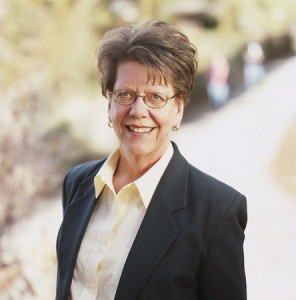By Kaye Terry Hanson, ’64
By looking nearer and farther, we can truly come to understand others.
AS an undergraduate English major at BYU, I read a short story by Thomas Wolfe called “The Far and the Near.” Wolfe writes about a train engineer who drove the same line for 20 years. At a certain crossing he had to blow the whistle, and then, just ahead, every day, a woman stepped out of her cottage and waved to him with a high, happy hand. Soon the woman came to wave with a child by her side; then over the years, the little girl became a grown woman, too. The woman waved summer or winter, sunny days or gray, and the man promised himself that someday he would go meet the woman.
Finally the day came. Retired from responsibility, he got off the train at the little town and walked to where the woman lived. He was shocked to find that it was not at all as he had imagined it. In fact, when he got up enough courage to knock at the door, he found the woman who greeted him at the door was not beautiful, not free, but pinched, sullen, and ugly. After struggling to explain why he was there, he left disappointed and sad.
I have thought about that story many times, considering what it means to look at something from far away and then close up. I discover that I am uncomfortable with the engineer’s conclusions. Both his far view and near view were false. He had not looked with eyes of truth, which would have allowed him to see from an eternal perspective, the Lord’s perspective, with an understanding heart. Mr. Wolfe’s engineer didn’t look near enough or far enough away.
Looking Nearer
In summer 2002 I set out to write a simple story about my father, Andrew Jensen Terry, an ordinary man. I hoped to capture his charm and humor and some of the tales from his life that I have loved since I was a child. I hoped my grandchildren might see that the elderly man who calls all his grandchildren “Butch” was once a child like they are.
Soon I realized that the book wouldn’t be complete without the stories of my wonderful mother, Lyla Wixom Terry, who was accidentally killed while I was a missionary in the South German Mission, and of my sweet stepmother, Edla Johnson Terry, who has been by my father’s side since he was little more than middle-aged—two ordinary women.
I searched for histories of my father’s parents, then of my mother’s parents, then of their grandparents, until I had cobbled together small stories of each grandparent up to four generations before me. I found ordinary people—farmers, teachers, a lumberjack, a tele-graph operator, railroad graders—people who were children in one story, young married couples in the next, who became the mothers and fathers who gave their skills freely to tame the wilderness of the American West. As I look nearer I find no bitter, sullen people here.
These are not ordinary people at all, though they didn’t know it. They are heroes—men and women who fought the elements, the economy, the challenges of the frontier, who carved out lives of honor and of glory. I regret I can’t get close enough. When we get right up close to people, we may see their warts, but we may also see their souls. And they are brave and beautiful.
Looking Farther Away
What does a broader view tell us about this earthly existence? I imagine our learning about coming to earth, rejoicing, understanding that this was the next step in our eternal progression. But in that pure spiritual environment,
I wonder, did we realize what it would mean to have the veil drawn?
I like places here that remind me of there. The temple is one of those places. The temple lets me look at the big picture of eternity with the Savior Himself at the center. And sometimes I get a glimpse of the whole thing, from the beginning to wherever never-ending is. And sometimes I almost understand.
One thing I understand for sure is that the Savior is the key to our whole earthly existence. I think of the baby in Bethlehem, the toddler in Egypt, then Nazareth, the stripling boy who learned to build things by Joseph’s side. I think of earthly parents teaching Him. I think of Galilee and the raging tempest, of Capernaum, where He taught and found friends like Peter and John. I think of Bethany, where He liked to stay with Mary, Martha, and Lazarus. He ate and slept and grew and laughed and was discouraged and enjoyed friends, just as we do. He underwent this mortal experience to learn and progress, just as we do. Because of that experience, He understands and loves us. If we work it right, this earthly experience will lead us to understand and love Him. “We love him,” says John, “because he first loved us” (1 Jn. 4:19). How else could He have endured Gethsemane, paying for your sins and mine with His whole self?
Our view must come closer again to examine what it means to love God, to love the Savior. We are caught in this finite existence and must work out our salvation from here. What must we do today to demonstrate that we love the Lord? The Lord said, “By this shall all men know that ye are my disciples, if ye have love one to another” (John 13:35).
Here are ways I have found to love others. The most important is praying for the gift of the Spirit that allows love.
Here’s another. I see my students at the first of the semester differently than I do at the end. As we work through the learning process together, I get glimpses of who they are, of what they hope, and sometimes, of what moves them. Getting to know them, connecting with them, finding what truths we share, what passions we carry, is one way that helps me love them.
Understanding who the people around us are is another way to love them more. When I was a first grader, going to second grade appeared to me to be the ultimate step in maturity. Second graders knew more than we did, and I longed for the day I could go to second grade. When that day came, to my surprise and dismay, I looked around the room and found seated there the same children I had been with in first grade. Nothing was different. Surrounding me were ordinary children, apparently no different than they were the last year. What a disappointment when I expected something much grander.

The engineer’s far view and near view were both false. He had not looked with eyes of truth. He didn’t look near enough or far enough away.
I have lived long enough to watch my classmates grow up, marry, rear families, wrestle with the economy, put food on the table, and set one foot in front of the other in doing the best they could.
C. S. Lewis understood—better than the engineer—who such ordinary people really are:
It is a serious thing to live in a society of possible gods and goddesses. . . . It is in the light of these overwhelming possibilities, it is with the awe and the circumspection proper to them, that we should conduct all our dealings with one another. . . . There are no ordinary people. You have never talked to a mere mortal. [The Weight of Glory and Other Addresses (New York: Macmillan, 1949), pp. 14–15; emphasis in original]
We must treat ourselves and those around us with more respect because of who they are, because of who we are. We are not ordinary people, none of us. We are gods and goddesses in training. For us to move forward, we must be better than we are in our simple dealings with one another. We must love one another. Not like or tolerate but love one another.
We are given time and opportunity to be molded like Jesus Christ. We are in a process. So are all those around us. By looking at this earth and its purpose from a broad perspective, we can sense the purpose of the exercise that moves us forward in becoming like the Savior.
Someday this mortality will put on immortality. Someday we will see not “through a glass, darkly[,] but . . . face to face” (1 Cor. 13:12). Because we are not just ordinary people, we must learn to see as John does: “Now are we the sons [and daughters] of God, and it doth not yet appear what we shall be: but we know that, when he shall appear, we shall be like him; for we shall see him as he is” (1 Jn. 3:2).
This article is adapted from the Dec. 3, 2002, devotional address, “The Far and the Near,” by Kaye Hanson, co-chair of the Faculty Advisory Council. The complete text is available at speeches.byu.edu.
THE QUEST FOR ETERNITY
By President James E. Faust
Learn to think spiritually. That is far harder to master than learning by rote the many facets of secular education. I emphasize spiritual thinking because secular learning is ever changing. Even the so-called exact sciences, with some exceptions, are changing. Spiritual knowledge and intelligence are unchanging and eternal.
. . . The quest for eternity begins now, this year, this month, this day, this moment.
—President James E. Faust, “Learning for Eternity,” Devotional Address, Nov. 18, 1997
MORE: The complete text of this talk is available at speeches.byu.edu.









